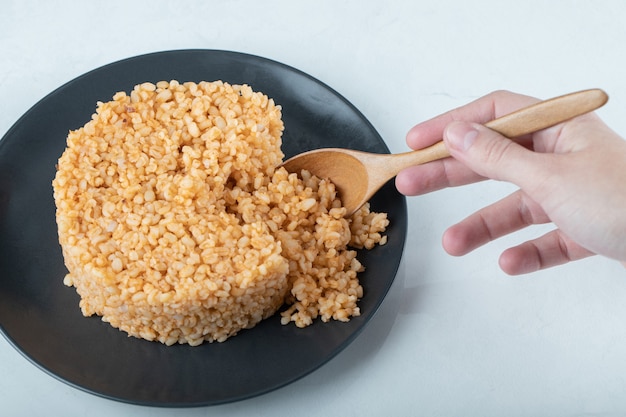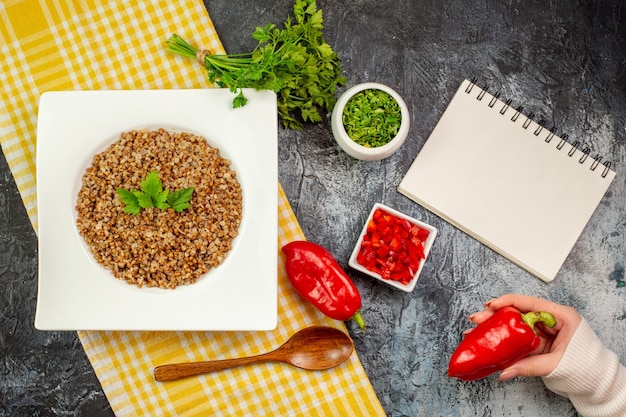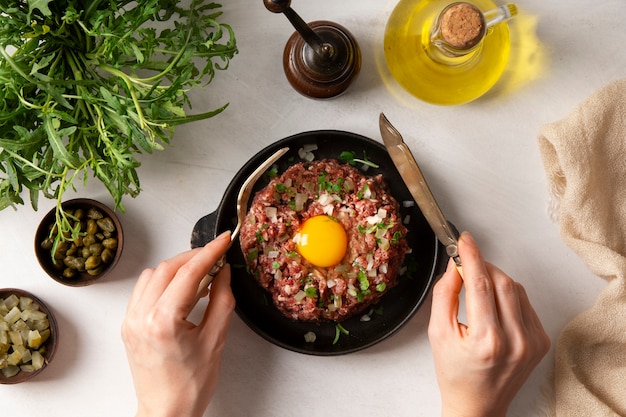There's a certain satisfaction that comes with a perfectly cooked pot of brown rice. It's got that delightful chewiness, a subtle nutty flavour, and a wholesome, comforting vibe that just makes you feel good. But for years, I struggled to get it right. My rice would either be mushy, undercooked, or simply lacklustre. I tried every trick in the book: rinsing, soaking, different water-to-rice ratios, even those fancy rice cookers. Nothing seemed to work consistently.
Then, one day, I stumbled upon a simple yet incredibly effective method for cooking brown rice on the stovetop. It was a revelation! Since then, I've been turning out fluffy, perfectly cooked brown rice every time. So, I'm sharing my secrets with you, my fellow rice enthusiasts. Get ready to experience the joy of consistent, delicious, and satisfying brown rice.
(Part 1) The Essentials: Choosing Your Rice

choosing the right rice: A World of Options
The first step to mastering stovetop brown rice is selecting the right type of rice. Not all brown rice is created equal, and the variety you choose will greatly impact the final texture and flavour. Here’s a quick rundown of some popular types:
- long-grain brown rice: This is the most common type, yielding fluffy, slightly chewy rice with a subtle nutty flavour. It's perfect for stir-fries, salads, and side dishes. Think of it as the classic versatile brown rice.
- medium-grain brown rice: As the name suggests, medium-grain rice falls somewhere between long and short grain. It’s a bit stickier than long-grain rice and has a slightly more pronounced flavour. It's great for rice bowls, sushi, and pilafs, where that extra stickiness can be helpful.
- short-grain brown rice: Short-grain brown rice is quite sticky and often used for making rice balls (onigiri) or in Japanese cooking. Its texture is more dense than long-grain rice, and it has a more pronounced earthy flavour. Think of it as the "glue" for sushi or rice balls.
- black rice: This rice is a bit more expensive than other varieties but offers a unique flavour and beautiful, almost black colour. It’s rich in antioxidants and has a chewy texture, making it a delightful addition to desserts or side dishes. It's a statement piece, visually and flavour-wise.
- red rice: Like black rice, red rice is a whole grain with a distinct flavour and a chewy texture. It's known for its high nutritional value and often used as a side dish or ingredient in salads. It's a great alternative to white rice with a vibrant colour.
Storage and Shelf Life: Keeping Your Rice Fresh
Once you’ve chosen your rice, it’s important to store it properly to maintain its freshness. Brown rice should be stored in an airtight container in a cool, dark place. Ideally, it should be kept in the pantry or refrigerator. It generally has a shelf life of 6-12 months, depending on the storage conditions. Remember, a good airtight container is key to keeping that rice fresh and flavourful for longer.
Rinsing the Rice: The Secret to Fluffy Grains
Before cooking, it’s essential to rinse your brown rice. This removes excess starch and impurities, resulting in a fluffier and more palatable rice. Simply place the rice in a fine-mesh sieve and rinse under cold running water until the water runs clear. This usually takes about 30 seconds. Be sure to shake off excess water before transferring the rice to your cooking pot. It's a quick and easy step that makes a big difference in the final outcome.
(Part 2) Mastering the Ratio: The Foundation of perfect rice

The Importance of the Right Ratio: It's Not Just a Number
The most crucial aspect of cooking perfect brown rice is getting the water to rice ratio right. Too much water will leave you with mushy rice, while too little will result in dry, undercooked grains. The ideal ratio is 2 cups of water for every 1 cup of rice. This ratio works consistently for all types of brown rice. It's a simple guideline, but it's the foundation for achieving that perfect texture.
Exceptions to the Rule: Personal Preference Matters
While the 2:1 ratio is generally a good rule of thumb, there are a few exceptions. Some people prefer their rice slightly softer or firmer, so you might want to experiment with the ratio to find your perfect preference. For instance, if you like your rice on the softer side, you might add a bit more water (maybe 2.25 cups). Conversely, if you like it a bit firmer, you might use slightly less water (perhaps 1.75 cups). But, remember to start with the 2:1 ratio and gradually adjust it to your liking. It's about finding what works best for your taste and how you intend to use the rice.
Using a Measuring Cup: Precision is Key
Using a measuring cup is essential for getting the water-to-rice ratio perfect. Don't just eyeball it! Use a standard measuring cup, preferably one with a spout for easy pouring. Make sure you’re measuring the rice properly – don’t pack it down, just gently level it off. This will ensure consistent results every time. It's like following a recipe for baking - the right measurements ensure a perfect outcome.
(Part 3) The Stovetop Method: Simple and Effective

Gathering Your Supplies: Keeping It Minimal
Cooking brown rice on the stovetop is surprisingly simple. You’ll only need a few basic supplies:
- A medium-sized saucepan: This should be large enough to hold the rice and water without overflowing. Choose one with a good lid and a thick bottom for even heating.
- A lid for the saucepan: A tight-fitting lid is essential for trapping steam and cooking the rice evenly. It creates a mini-pressure cooker effect.
- A fine-mesh sieve: For rinsing the rice. This is a kitchen essential for more than just rice.
- A measuring cup: For measuring the rice and water accurately. It's a kitchen staple for any cooking.
- Salt: For flavour. A pinch of salt brings out the best in any rice.
The Steps: A Recipe for Success
- Rinse the rice: As mentioned earlier, rinse your chosen brown rice thoroughly in a fine-mesh sieve. Get rid of any excess starch and impurities for fluffy rice.
- Combine the rice and water: In your saucepan, add the rinsed rice and the appropriate amount of water based on your chosen ratio. Start with the 2:1 ratio, then adjust based on your preference.
- Add salt: For extra flavour, add a pinch of salt to the water. A teaspoon or two is usually enough. A tiny bit of salt makes a big difference in taste.
- Bring the mixture to a boil: Place the saucepan on the stovetop and bring the water to a rolling boil over medium-high heat. You want to get those bubbles going.
- Reduce heat and simmer: Once the water is boiling, reduce the heat to low, cover the pot with a lid, and simmer for 30-40 minutes. This is where the magic happens – low and slow cooking.
- Let the rice rest: After 30-40 minutes, turn off the heat and let the rice rest, covered, for another 10-15 minutes. This allows the rice to absorb the remaining water and become fluffy. It's the secret to achieving that perfect fluffy texture.
- Fluff the rice: After the resting period, fluff the rice with a fork to separate the grains. It’s ready to be served! It should look like a cloud of deliciousness.
(Part 4) Beyond the Basics: Tips and Tricks for Elevated Rice
Adding Flavor: Beyond Plain
While plain brown rice is delicious on its own, you can add a burst of flavor by adding herbs, spices, or other ingredients to your cooking pot. For instance, you could add a bay leaf, a few sprigs of thyme, or a pinch of cinnamon to the cooking water for a subtle but noticeable flavor. It's like adding a touch of magic to your rice.
Cooking with Broth: Richer, More Flavorful Rice
For a richer, more flavourful rice, use broth instead of water. chicken broth, vegetable broth, or even a simple homemade broth can elevate your rice to a whole new level. It's like adding a hidden depth of flavour.
Using a Rice Cooker: Hands-Free Cooking
If you want to take the guesswork out of cooking brown rice, consider using a rice cooker. These appliances are designed specifically for cooking rice and take care of the timing and temperature, ensuring perfect results every time. It's the ultimate convenience for busy lives.
Storage and Reheating: Keeping It Fresh and Delicious
Once cooked, brown rice can be stored in an airtight container in the refrigerator for up to 5 days. To reheat, you can microwave it, steam it, or gently heat it in a saucepan with a little bit of water. It's great for meal prepping or having leftovers for lunch.
(Part 5) The Science Behind Perfect Rice: Unveiling the Starch Secrets
The Role of Starch: The Key to Texture
The key to achieving fluffy, perfectly cooked brown rice lies in understanding how starch works. Brown rice contains two types of starch: amylose and amylopectin. Amylose is responsible for the rice’s structure and texture, while amylopectin is responsible for its stickiness. When you cook rice, the starch granules absorb water and gelatinize, forming a cohesive structure. However, too much water or prolonged cooking time can cause the starch to break down, resulting in mushy rice. It's a delicate balance between starch, water, and heat.
The Importance of Resting: The Finishing Touch
The resting period after cooking is crucial for achieving the perfect texture. During this time, the rice continues to absorb the remaining water and the starch gelatinization process completes, resulting in fluffy, well-defined grains. It's like giving the rice a chance to fully develop its flavour and texture.
(Part 6) Serving Suggestions: Exploring the Possibilities
The Versatility of Brown Rice: A Culinary Chameleon
Brown rice is a remarkably versatile ingredient that can be incorporated into a wide range of dishes. It’s a staple in many cuisines worldwide, and its mild flavour and satisfying texture complement a variety of flavours and ingredients. It's like a blank canvas waiting for your culinary creativity.
Simple Sides: The Classic comfort food
A simple bowl of steamed brown rice with a pat of butter or a drizzle of olive oil is a classic and comforting side dish. You can elevate it further by adding herbs, spices, or toasted nuts. It's a comforting and satisfying dish that never fails to please.
Salads and Bowls: Adding Texture and Substance
Brown rice adds texture and substance to salads and bowls. It pairs beautifully with vegetables, proteins, and dressings. It's a hearty and nutritious base for healthy meals.
Main Courses: A Versatile Ingredient
Brown rice can be incorporated into main courses as well. It’s delicious in stir-fries, pilafs, and rice bowls. It can be a star ingredient or a subtle supporting role in your culinary creations.
Desserts and Treats: Sweet Surprises
You might be surprised to learn that brown rice can even be used in desserts! Its nutty flavour and chewy texture work well in rice pudding, rice flour cakes, and other sweet treats. It's a unique twist on traditional desserts, adding a subtle nutty flavour.
(Part 7) Beyond Nutrition: The Environmental Benefits
A Sustainable Choice: Good for You and the Planet
Beyond its nutritional value, brown rice is a sustainable choice. It’s an environmentally friendly grain that requires less water and energy to grow than many other grains. It’s also a good source of fiber, which can help regulate digestion and promote gut health. It's a win-win for both your health and the environment.
Reducing Your Carbon Footprint: Making a Difference
By choosing brown rice, you’re making a positive impact on the environment. It’s a simple yet impactful change that can help reduce your carbon footprint and contribute to a more sustainable future. It's a small change that makes a big difference.
(Part 8) FAQs: Addressing Common Questions
1. What if my rice is still undercooked after 40 minutes?
If your rice is still undercooked after 40 minutes, it could be due to a few reasons: You might have used too little water, the heat might have been too low, or the rice you used might be old. Add a little more water and cook for a few more minutes. If that doesn’t work, try using a different batch of rice. It's always a good idea to check the expiry date of your rice.
2. Can I cook brown rice with other grains?
Absolutely! You can cook brown rice with other grains like quinoa, barley, or wild rice. This is a great way to add variety to your meals and increase the nutritional value. Experiment with different ratios to find your favorite blend. It's a fun way to explore different flavours and textures.
3. How do I know if my brown rice is done?
The best way to know if your brown rice is done is to taste it. The grains should be tender and slightly chewy, but not mushy. If the rice is still hard or crunchy, cook it for a few more minutes. It's the best way to ensure you get the perfect texture.
4. What are some good recipes for brown rice?
There are countless delicious recipes that feature brown rice. Here are a few to get you started:
- brown rice salad with grilled chicken and mango: A refreshing and flavorful salad that’s perfect for warm weather. It's a light and satisfying meal.
- Brown rice stir-fry with vegetables and tofu: A quick and easy vegetarian stir-fry that’s packed with flavor. It's a great option for a healthy and delicious dinner.
- brown rice pudding with cinnamon and nutmeg: A comforting and delicious dessert that’s perfect for a cozy night in. It's a warm and comforting treat.
5. Can I freeze cooked brown rice?
You can freeze cooked brown rice for up to 3 months. To freeze it, spread the rice in a single layer on a baking sheet and freeze for a couple of hours, then transfer it to an airtight container. To reheat, thaw it in the refrigerator overnight and then microwave or steam it. It's a great way to save time and have a quick meal ready whenever you need it.
(Part 9) Conclusion
So there you have it! My ultimate guide to mastering the art of stovetop brown rice. From choosing the right rice to getting the ratio just right, I’ve covered all the essentials for creating fluffy, perfectly cooked brown rice every time. Now, you can confidently enjoy this wholesome grain and all its delicious possibilities. It's a simple yet rewarding skill to learn.
Remember, cooking should be a fun and enjoyable experience. Don't be afraid to experiment and find what works best for you. Get creative with flavors, try different techniques, and most importantly, enjoy the process! And who knows, maybe you’ll even discover your own secret to achieving perfect brown rice. It's about finding your own personal touch in the kitchen.
Everyone is watching

Prime Rib Roast Cooking Time Chart: Per Pound Guide
Cooking TipsPrime rib roast. Just the name conjures images of lavish dinners, crackling fires, and hearty laughter. It’s ...

How Long to Bake Potatoes in the Oven (Perfect Every Time)
Cooking TipsBaked potatoes are a staple in my kitchen. They're incredibly versatile, delicious, and surprisingly easy to m...

Perfect Rice Every Time: The Ultimate Guide to Cooking Rice
Cooking TipsAs a self-proclaimed foodie, I've always been a bit obsessed with rice. It's the foundation of countless cuisi...

The Ultimate Guide to Cooking Asparagus: Tips, Techniques, and Recipes
Cooking TipsAsparagus. The mere mention of this spring delicacy conjures up images of vibrant green spears, crisp and burs...

Ultimate Guide to Cooking the Perfect Thanksgiving Turkey
Cooking TipsThanksgiving. Just the word conjures up images of overflowing tables laden with delicious food, the scent of r...
